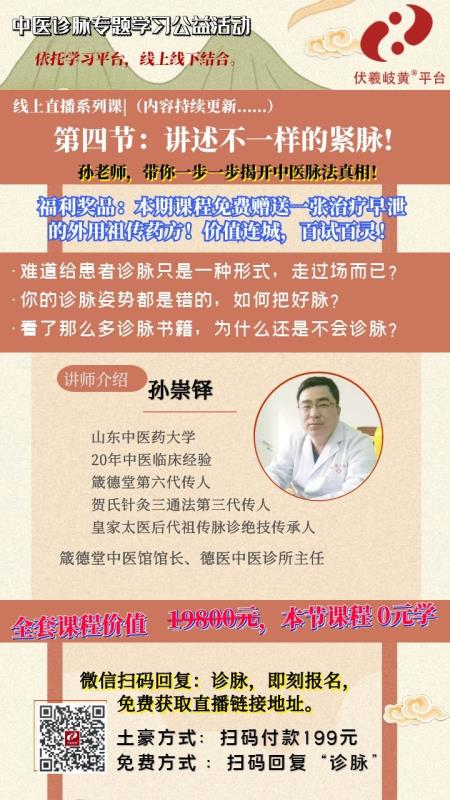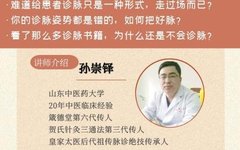1
Long and Short Pulses (with Small Pulses)
The continuous circulation of Yin blood relies entirely on the propulsion of Yang Qi.
Therefore, when the Yin blood within the pulse vessels is abundant, and the Yang Qi outside the vessels is vigorous, the force of propulsion is enhanced, leading to an increased output of blood, resulting in a long pulse;
Conversely, when the Yin blood within the pulse vessels is insufficient, and the Yang Qi outside is in a weakened state, the force of propulsion diminishes, leading to a reduced output of blood, resulting in a short pulse.
This is why ancient practitioners stated that a long pulse indicates excess, while a short pulse indicates deficiency.
However, pulse diagnosis must be flexibly applied in conjunction with the patient’s condition and should not be rigidly interpreted.
If the patient’s constitution is still strong and the illness is mild, a long pulse that is also soft indicates a harmonious relationship between form and Qi, which is not a pathological pulse but rather a sign of abundant organ Qi; if the pulse is not long but appears short, it indicates that although the form is solid, the righteous Qi is already damaged, which is a cause for concern even if the illness is mild.
On the contrary, in cases of chronic illness with a weak constitution and severe condition, a short pulse indicates a deficiency of righteous Qi and a deficiency of both form and Qi, which can be dangerous;
If the pulse is not short but appears long with a taut and strong quality, it indicates a deficiency of righteous Qi with an excess pulse, showing an external strength but internal weakness;if the pulse appears long but is also soft, it indicates a condition of abundant original Qi, suggesting that despite the severity of the illness, there is a chance for recovery.
From this, it can be seen that a short pulse indicates a deficiency of original Qi, which is an unfavorable sign regardless of whether it is a new or chronic illness.A long pulse indicates an excess of original Qi, and as long as it is accompanied by softness, it is not harmful in the presence of various diseases.
Thus, the Suwen: Pulse Essentials states: “Long indicates Qi is healthy, short indicates Qi is ill.” This indicates that a short pulse is indeed a pathological pulse, while a long pulse does not necessarily indicate a pathological condition.
Later practitioners have treated long pulses as a sign of excessive Yang fire; however, a pulse characterized by excessive Yang fire must also exhibit a strong and forceful quality, resembling a solid pulse rather than merely a long pulse.
As for small pulses, their quality is short and small, unlike thin pulses which are merely thin and long; short pulses are short but not thin. This indicates a deficiency of Yin blood and a weakness of Yang Qi. When Yin blood is low, the pulse is less filled and thus appears thin; when Yang Qi is weak, the force of propulsion is diminished, leading to a short output of blood.
Therefore, the Ling Shu: Evil Qi and Organ Disease states: “Large indicates much Qi and little blood, small indicates both Qi and blood are deficient”; it also states: “All small pulses indicate a deficiency of both Yin and Yang Qi, and should not be treated with needles but rather supplemented with sweet herbs.” This indicates that small pulses are a sign of deficiency in both Yin and Yang Qi, and should only be treated with tonification.
2
Flooding and Large Pulses
Flooding and large pulses both indicate a sign of abundant Qi and fiery heat, differing only in degree.
The human body is governed by Yin and Yang, which represent water and fire, and water and fire represent Qi and blood.
If a warm pathogen invades internally, or if an internal pathogen transforms into heat over time, the heat pathogen supports Yang, leading to an excess of Yang, which is equivalent to an excess of fire, and an excess of fire results in an excess of Qi transformation.
This Qi, with insufficient water and Yin, and an excess of Yang heat, leads to an outward expansion of Yang Qi, enhancing the force of propulsion, thus the pulse becomes superficial; when the heat pathogen presses inward, the pulse vessels expand due to the heat, resulting in the formation of a large pulse.
If Yang Qi further becomes excessively vigorous, and heat obstructs internally, affecting the three burners and the muscles and skin externally, it is purely the action of the heat pathogen. When fire is excessive, Qi becomes more abundant, and the force of propulsion becomes stronger.
Previously, blood was guarded by Qi, but now Yang Qi is in action, causing blood to surge uncontrollably, hence the pulse is not only large but also slippery and rapid, surging like boiling water, which is the formation of a flooding pulse.
From this, it can be seen that both flooding and large pulses belong to the condition of abundant Qi and fiery heat, which is quite evident. When Yang Qi is excessive, Yin blood suffers from its pathogen; when the heat pathogen is severe, the water and Yin Qi are harmed.
Thus, the Neijing states: “A large pulse indicates the disease is progressing,” “A large pulse indicates much Qi and little blood,” and “A flooding pulse is a hook, governing the summer months, indicating excess.” All these phrases refer to both pulses as signs of excessive Yang heat, and caution must be taken to prevent harm to Yin Qi. Therefore, if a large pulse is seen as deficient, and a flooding pulse is seen as hollow, then in clearing heat, one must also include products that generate fluids; otherwise, although the heat pathogen is removed, the true Yin will be depleted, which is not the correct treatment.
As for the statement in the Jinkui Yaolue: Deficiency and Labor that “a man’s pulse being large indicates labor,” it refers to internal injuries from emotions, depletion of essence and blood, and an excess of Yin deficiency and fire, leading to an excess of Qi, which is different from the aforementioned large pulse caused by external pathogen interference. Thus, the treatment principles differ: the former focuses on clearing heat, while the latter emphasizes nourishing Yin, one being deficient and the other being excessive, which is a significant difference.
3
Weak and Soft Pulses (with scattered pulses)
Weak and soft pulses have been poorly understood by many practitioners throughout history.
Weak pulses are thin, while soft pulses are fine; when both weak and fine pulses are seen in a superficial manner, it is termed weak, and when both are seen in a deep manner, it is termed soft. The main differences and similarities between these four pulse qualities are thus established.
Since weak pulses indicate a deficiency of Yang Qi, and fine pulses indicate a deficiency of Yin blood, the combination of weak and fine indicates a deficiency of both Qi and blood. Now, both weak and soft pulses exhibit the qualities of being fine and weak, thus both pulses indicate a deficiency of Qi and blood.
The difference is that a weak pulse appears in a superficial manner, indicating that although both Qi and blood are deficient, Yang Qi still has a slight outward floating force. This indicates that Yin blood is severely depleted, and the residual Yang has no support, thus the pulse appears fine and soft, yet can still be felt in a superficial manner.
A soft pulse appears in a deep manner, indicating a deficiency of both Qi and blood, with a more pronounced deficiency of Qi. When Qi is deficient, the force of propulsion is weakened, leading to a lack of vitality, hence the pulse appears fine and soft, only detectable in a deep manner. This indicates that both weak and soft pulses indicate a deficiency of both Qi and blood, with one being more Yin deficient and the other more Yang deficient.
Generally, individuals have different constitutions, and the causes of illness vary, leading to unpredictable changes. Some may have Qi deficiency without blood deficiency, while others may have blood deficiency without Qi deficiency; some may have both Qi and blood deficiency leaning towards Qi deficiency, while others may have both Qi and blood deficiency leaning towards blood deficiency; some may have extreme Qi and blood deficiency leading to further Qi deficiency, while others may have extreme Qi and blood deficiency leading to further blood deficiency.
On the surface, it appears to be merely Qi deficiency and blood deficiency; however, due to the varying degrees of deficiency, the changes in pulse quality are also different. For instance, weak pulses indicate Qi deficiency, while soft pulses also indicate Qi deficiency; fine pulses indicate blood deficiency, while weak pulses also indicate blood deficiency; the issue is that the weakness and softness are both based on extreme deficiency of Qi and blood, leaning towards blood deficiency or Qi deficiency.
Thus, the degree of deficiency varies, leading to different pulse reflections, and this pulse diagnosis must analyze the principles of Yin and Yang, water and fire, Qi and blood deficiency and excess.
It is essential to clarify this principle to accurately classify pulse types, distinguish between deficiency and excess, and weigh the severity, achieving a flexible application of the principles.
As for scattered pulses, they are characterized by a floating, scattered, and large quality, with no clear presence upon palpation, appearing indistinct and lacking foundation, unlike weak pulses which are thin and not scattered, and unlike soft pulses which are fine yet have a foundation. This indicates a complete depletion of Yin blood and a dispersion of Yang Qi. Such a pulse indicates a condition that should not be treated.
Note: This article is excerpted from Zhutang Yijing, authored by Qian Yuanming, edited by Cai Yuqin and Li Xuanjin, published by Central China Normal University Press, December 1992.


